Now we start the task of removing all the various parts from the wood cabinet. Again, there’s no real pre-defined order to this process, we’re just going to remove the parts that are the easiest to access. First, we’re going to remove the levers that lock the back bonnet in place when the case is together.
As you can see, this particular part is already missing from the handle-side of the machine (it was in the cash box when I bought the slot, so at least I won’t need to find a replacement.) On the other side, you can see the part in question at the top of the cabinet. It’s secured with a screw and a carriage bolt. While we’re at it, we’re also going to remove the parts indicated by the other arrows. The bottom part is a locking bar that keeps the mechanism base plate in place (held onto the cabinet again by a screw and a carriage bolt) , and the middle part is a very simple holding device that keeps the locking bar out of the way when you are removing the mech from the case. I’m not going to photograph these parts separate from the cabinet since they are all very simple and self-explanatory. I’m removing all of these parts from both sides of the cabinet.
Next, I’m going to remove the armor plating from the non-handle side of the cabinet.
This is a simple part that was designed to inhibit cheating, making it harder for someone to drill a hole in the side of the cabinet and use a wire to stop the clock, trip the jackpot or otherwise manipulate the mechanism. It’s easy to remove, but depending on the screws left in the cabinet you may have to remove a few.
With the armor plating removed, we’re down to bare wood on this side of the cabinet.
At the very top of the cabinet in the photo above, you can see one last metal part attached to the cabinet side. This is another security feature, and is held in place by one or two screws. I’m going to remove it now, although some people advise leaving it in place to add some structural integrity to the cabinet side for later when we separate the sides from the base. In reality, that’s probably a better approach, so let your best judgment guide you.
Now we’ll move along to the other side of the cabinet, where we’ll find all of the handle hardware.
The handle starting lever needs to come off, and it’s secured to the case by a spring and to the pump linkage by a cotter pin (or in this care, a bent nail.) It’s also secured to the handle itself by a large nut in the center. Please also note the arrow above that points to a carriage bolt. This doesn’t need to be removed just yet, but it’s important to note that it is a shorter carriage bolt than many on the machine. The handle starting lever must be able to clear this bolt/nut in order to work, so remember that for later.
The handle starting lever is missing a small dog and the related spring, but luckily I already have a spare.
Moving along, let’s remove the handle starting lever bracket assembly and the handle arm bushing.
In the photo above you can see the three screws that connect these two parts together. If you haven’t already removed the short carriage bolt I mentioned above, you need to remove it now. These parts are generally very greasy, so act accordingly.
Here’s the cabinet with those parts removed.
Now we’re going to look at the front of the cabinet and talk about a few parts.
We’re going to be removing the sub-base plate next, which is the large cast iron plate that the mechanism sits on when it is in the case. This part is secured to the bottom of the case by four carriage bolts, two on each side of the cabinet. You should be able to find them easily, but the sub-base is also connected in other places. The two brackets pictured above (one installed, the other just laying in place) are the ones we discussed when removing the lower front casting. They don’t need to be removed in order to get the sub-base out, but I wanted to document them so that you could see where they are supposed to be installed. Also, take a look at the coin cup and cover. They are connected to the sub-base plate by two screws and rectangular washers identified below.
Lastly, the sub-base plate is sometimes connected to other parts of the cabinet by wood screws as pictured below.
Once you get all of these screws, bolts and such out of the way, the sub-base plate should lift right out.
Here’s what the cabinet looks like with the plate removed:
At this point we want to remove the pump and related linkage parts. Here’s what they look like still mounted to the cabinet:
The easiest thing to do here is to remove the pump from it’s mounting bracket, and then disassemble the linkage parts. The pump is held to the bracket by a couple of screws.
There’s one last piece remaining on the machine, held in place by a carriage bolt.
With these parts removed, you can either remove the handle mounting bracket now, or leave it on the cabinet base to provide the cabinet with some added rigidity when we remove the sides. I’m going to leave it in place for now. With this piece removed, the armor plating will be free to come off, and the top rail will also be accessible. I’m not going to photograph those parts since removing them is pretty much the same process that we did for the other side.
Next we’ll tackle the coin cup and cover.
There’s a screw in the back of the coin cup cover that needs to come out, and there may be other screws in more obvious places, but all of these screws should be easy to locate and remove.
That leaves just the coin cup and related molding, pictured below.
These parts are secured to the cabinet base with a couple of screws, so you’ll have to tip the cabinet up to get to the underside. In this particular case, however, there’s a bit of a surprise waiting for me.
First off, the cabinet base has split and separated at a point right behind the coin cup hardware. I was expecting this, so no big deal there, but it’s also lost some of its thickness at some point and been glued to some sort of fiberboard base. This is not a good thing, since that can’t really be refinished. In addition, someone has cut a very ragged hole in the base itself. You sometimes see this on some vintage machines for a couple of reasons. Some operators would cut this kind of hole to correspond to a hole in whatever stand they were using for the machine and hang a cash bag instead of using a cash box. Other times the operator would cut a hole and use it for hardware that would lock the machine to a stand as a security measure. In either case, this sort of modification is known by the technical term “crap.” Here’s what the remaining portion of the base looks like with the loose piece put in place, and with the fiberboard removed:
It looks like the base may have sustained some water damage at some point, and that might be the reason for the fiberboard addition.
There are a couple of paths I could take on this restoration, given what we now know about the base. I could glue the cabinet base parts back together and cut a new piece of thin wood to take the place of the fiberboard, but then I’d have to deal with the hole somehow. I could buy a whole new cabinet, or just a cabinet base (both of which are readily available.) I’m not going to decide just yet, however, since I still need to get the cabinet sides separated from the base. If the sides give me trouble or reveal more surprises, then I might need to get a whole new cabinet. Hopefully, though, I’ll just have to worry about the base. We’ll be talking more about the cabinet in our next chapter.
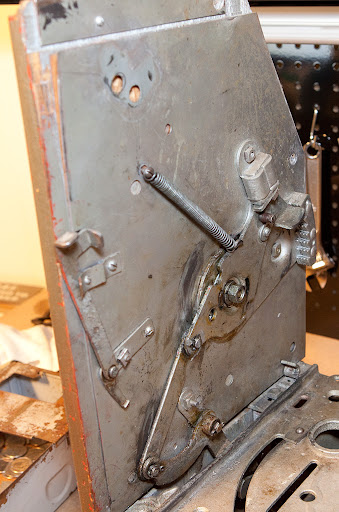
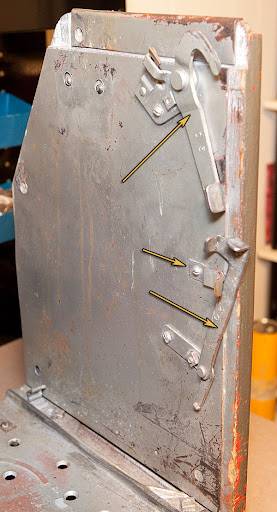
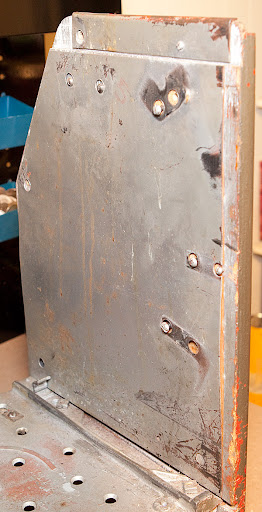


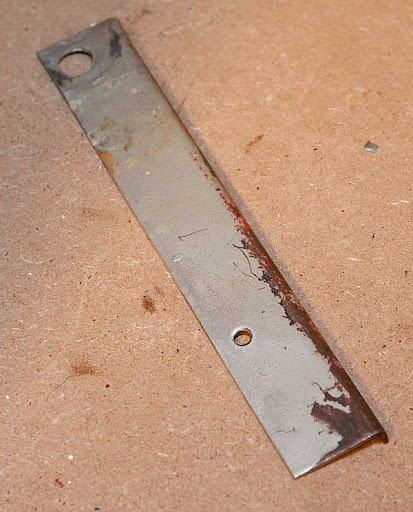
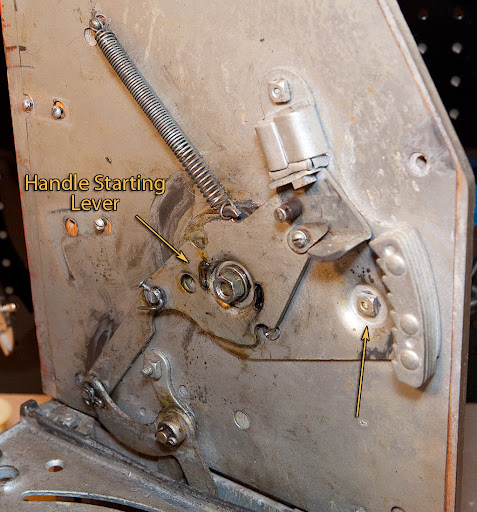
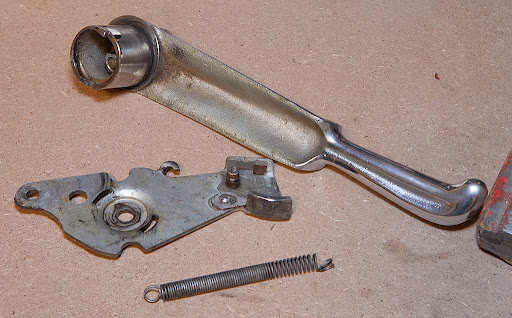
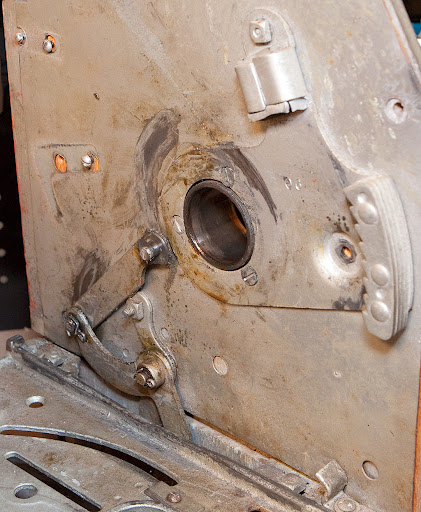
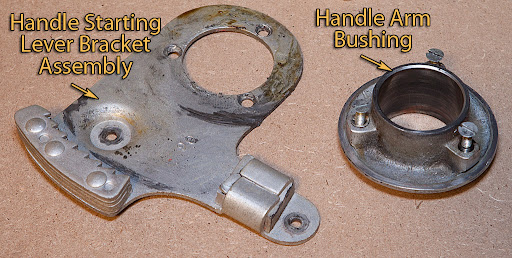

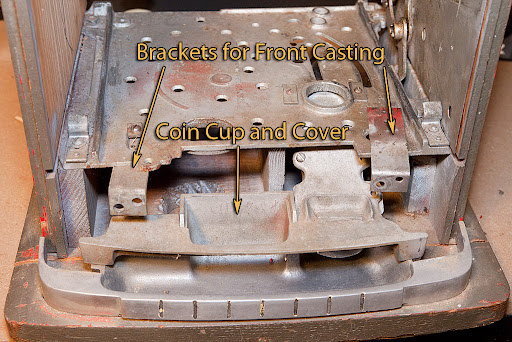

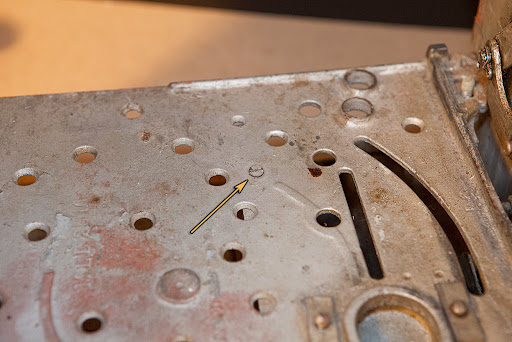





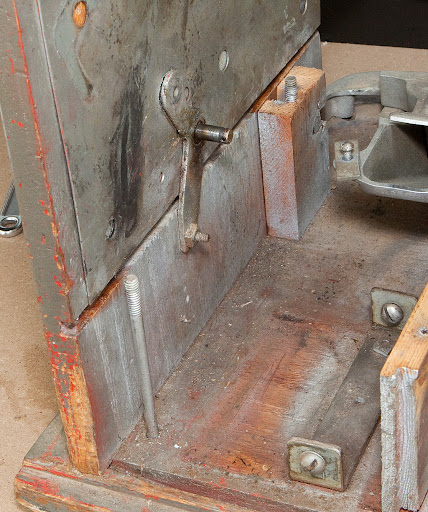
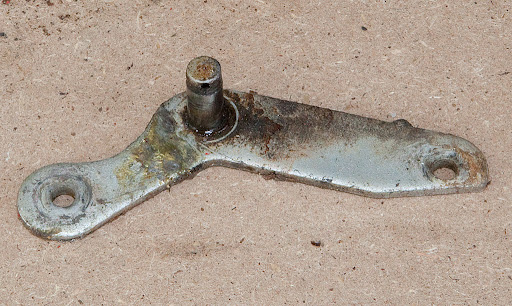

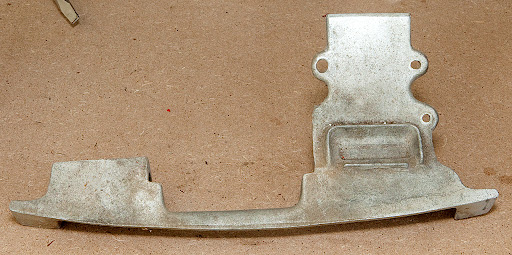

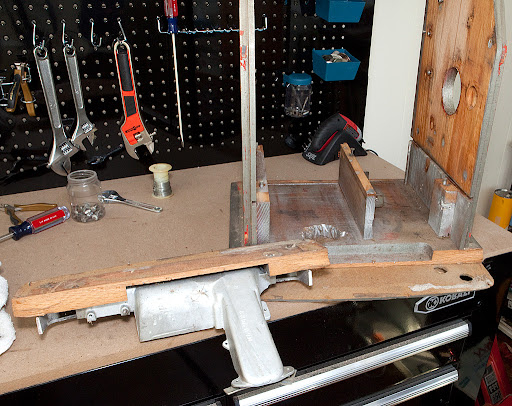
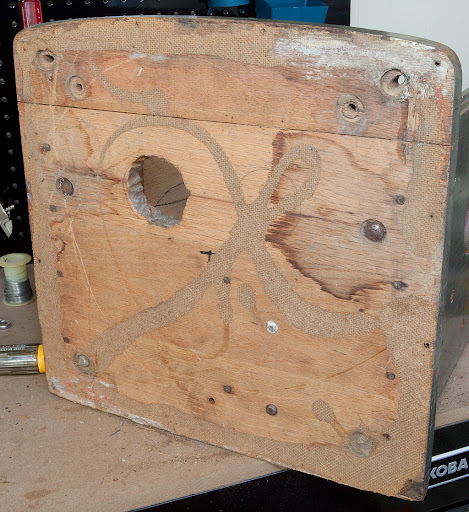
Hi,
My name is John , from the Netherlands.
I’m following your blog for a while now , best restoration source for a Hightop on the internet !!!
Because of your blog, i’ll start the restoration of my “Mills Hightop 777 5c” in a few weeks.
Your blog is realy a great help for me.
Can i ask you where you buy your parts , i seeked the internet and did’nt find a good source yet.
Keep up the good work !!
kind regards,
John Broer
Netherlands
Hi, John. I’m going to do a somewhat complete list of parts resources later on, but for now you might want to start with the following resources:
Squires and Corrie - They have a few parts online, but have many more than they can show on the web. The owner is a really helpful guy and a pleasure to deal with.
Bernie Berten – email mrslot1@aol.com for a catalog – Lots of parts and some tools.
Krahl Classic Antiques – I haven’t bought from them yet, but they have a very complete parts catalog online.
I hope that helps to get you started. Thanks for the kind words and for following along!
Excellent work!
couple questions:
1- is there any way to stop the Handle Starting Lever from wearing down the inside of the case? or was that just improper reinstallation many years ago that caused this? (just wondering cause my machine has slight wear just like yours)
2- how do you restore or clean up the leather pump i’ve seen some people who have some very nice brass or polished ones and would love to take my machine to that point.
Hi, Broodwich, and thanks for visiting.
1. There isn’t really a lot of wear here, and I think once the machine is cleaned up you will see what I mean. I think what you are seeing is just scuff marks in grease, but feel free to clarify if I’m not understanding you.
2. I’m going to take the pump apart later and photograph it, and that will probably answer some of your questions. Different machines have pumps that are made out of different materials, and some of them are indeed brass. Once brass is cleaned up and degreased, it generally polishes up really well with Brasso or a similar metal polish.
Thanks again for writing!
Enjoyed this series very much. I produced a similar thing on DVD a few years ago. Interesting how you strip down the mechanics. Hope we get to see the completed article!!! Good Luck.
Thanks for the kind words! I’ve had a busy Spring that has kept me away from the workbench, but I’m hoping to make some more progress shortly.
What a great resource
Your tear down so far has shown me a few things (and behind a few things) that I hadn’t known about. Am rejuvenating a full height Mills Extraordinary and used one shot of your escalator to correctly replace a missing spring. As you say, restoration photo’s and explanations are a rarity…this one has been of practical use to me already and I intend to check back often.
Best wishes for the repairs and the rebuild.
Thanks, Mark. My non-slot schedule is starting to ease up a bit, so hopefully I will get back to the machine soon. I’m glad the photos helped you in your efforts on the Extraordinary, which is a great looking machine. I turned down a chance to buy a nice original Extraordinary years ago, and I’ve kicked myself ever since for not buying that machine! It’s just like the old saying goes, too… you regret the things you DIDN’T do more than those you did.
Hope your restoration goes well!
This series was terrific. I was very interested in seeing how it ends. Nave you finished? Please let us know. Thanks